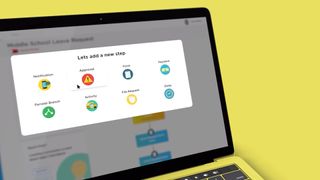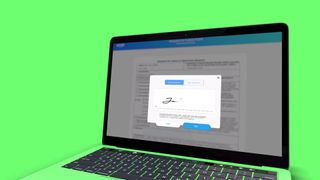
When you purchase through links on our site, we may earn an affiliate commission. Here’s how it works.

A Student Information System, or SIS, is a web-based platform that helps schools and colleges take student data online for easier management and better clarity. That's at its most basic.
The SIS system is able to collect school-wide data online so that it can be easily accessed by teachers, parents, students, and administrators. That includes personal student information, grades, records of tests, attendance, appraisal performance, and plenty more.
Essentially, a SIS allows the school to make data points for lots of areas in one place so that it's easy to keep track of progress and performance.
To be clear, it's an SIS we're talking about here, which can also break down into a Student Management System (SMS), Student Information Management System (SIMS), or Student Records System (SRS) - all created to help keep records digitally.
These systems can be used within a school for student data or information on the school as a whole. But the platforms can also be used to manage multiple institutions district-wide, say, to get a clearer view of how schools compare on very specific metrics.
The key with an SIS, over a more traditional WebCT, SCT Campus Pipeline, Jetspeed, or Blackboard, is that this online platform allows data that might otherwise be spread across multiple locations to be available in one easily accessible place.

Objectives of Student Information Systems
Tools and ideas to transform education. Sign up below.
By submitting your information you agree to the Terms & Conditions and Privacy Policy and are aged 16 or over.
The Student Information System is a resource that offers a self-service solution for students to get their administrative tasks done in one place. Equally, it is can support faculty and staff by helping to simplify and integrate work processes.
Since the SIS can be used as a digital dropbox, it's ideal for parents who want to access information on their child, communicate with the school, and even make payments.
The ability to standardize data formats between divisions means a more unified and clear data readout at a glance, ultimately saving time. Data integrity, privacy, and security can all be protected in an open-access environment.
When it comes to student records, an SIS offers high efficiency as all data is automatically organized and stored for easy access whenever it is needed.
Since the platform is cloud-based, is can be reconfigured as needed to make sure it grows with an institution. Most SIS offer open interfaces and integration with other campus applications and database systems, making for ease of use.

Information storage is what an SIS does at its most basic. That means records consolidated all in one place for students, teachers, and parents to access. Reports can be created on anything, from how many students are local to what GPA is in any given class.
In the case of K-12, there are parent specific portals that allow guardians to access information on their student. This allows them to see attendance, academic planning, behavior, and more, as well as to communicate with teachers. At universities this is useful in a similar way to allow students and lecturers communicate privately.
Administration for students is made easier with a Student Information System. Monitoring student progress and updating profiles often happens in real time.
Bringing together otherwise siloed departments is a special feature of the SIS that is able to place information, data, and resources in a universally accessible place. This allows for open communication across an institution.
As all this data storage and handling is cloud-based, so it is super secure. Setup is often easier, access is wider, technical support is immediate, and adaptations to changes is more easily possible.
Billing and payments can also be taken care of by the system. Parents or students can be invoiced, payments can be made, and the school can see and control it all from one place.

Admissions is one of the best areas that a Student Information System can create better efficiency. The entire enrollment process can be tracked in one system, from initial inquiry to acceptance and enrollment. For example, an institution can use an auto reply feature to respond to student queries with a selection of standard responses – saving administrative time.
This database that is built during the admission process can be used to send admission letters or regret letters to those prospective students.
For those students inputting information, the system will store all the main and optional subject choices. This is then later used to automatically create subject classes and assignments for teachers.
In most cases, a centralized e-Advising system can send a preregistration notice to students. A web link can provide access to a complete academic planning network that includes information about various programs, courses, fee structures, further progress, and other employment openings.
Details such as students seeking accommodation in a university scenario are kept separately for assigning rooms.

One of the great ways integration happens using a Student Information System is with billing and accounting. This is also pulled into the administrative process allowing most of the processes to be automated. That, once again, means saving time and money.
Accounting features including maintaining a general ledger, billing for students, all payable and receivable details, and project funding and accounting details.
The inbuilt automated contact management software in the system enables systematic, regular mails with details about any fee paid or not yet paid by students. The shared database provides details of college, housing, or any other fee receivable from a single source for easy follow-up and future auditing.
These systems play a vital role in helping deserving students to apply for financial aid for continuing education. Information, such as various financial aid opportunities, total fund availability, budget allocation, and received applications with eligibility criteria, allows the system module to efficiently verify an application and allot aid. Systems can even be programmed to ensure the periodic and timely distribution of financial aid.
Monitoring student-related activities
A complete record of students’ attendance and leave details is stored in the system. The reminder option in the system informs the institution management about the irregularities in the attendance or leave details for further action. This system offers a complete follow-up on all the discipline records of the students. With appropriate inputs, it offers an easy follow-up on bad elements to maintain institutional discipline. The student information system facilitates recording of all communication details with the students for regular follow-up and future use.
Easy scheduling of examinations
Scheduling of examination dates can be easily handled by a student information system. It correlates all details such as availability of teachers and completion of book syllabus fixed for the term before announcing the examination dates. Details about records of all written examinations, appraisals on the papers, marks or grades offered, and educational headway made by the students can be recorded for easy retrieval.
Communicating to parents, teachers and administrators
Student information systems are integrated with the parents’ portal for regular update of student-related information and feedback. The advanced systems enable creation of a user name and password for protected access to such information. The real-time availability of all student-related information such as attendance, marks or grades obtained in term examinations, and class and examination timetables enables parents, teachers and administrators to interact using the web interface for improving the performance of students.
Arranging of financial aid
Currently, computerised student information systems play a vital role in helping deserving students to apply for financial aid for continuing education. With all the compiled details such as various financial aid opportunities, total fund availability, budget allocation, received applications with eligibility criteria, the system module can verify the applications and allot aid in a shorter duration. On the basis of the fed details the system even arranges for periodic and timely distribution of financial aid.
Managing placement services
The student information management systems keep track of all the eligible students for part-time placement services to supplement educational expenses. The institutional payroll department identifies the positions available within the university and encourages students to apply for them. Similarly, while arranging placement services for final-year students, the available comprehensive details in the student record systems are sent to prospective employers who offer campus placement services.
Student information systems generally have the following features:
· Offer an easy-to-use interface for any normal user. Since all the applications are predefined, details only need to be filled in the required fields of information; multiple screen inputs are avoided for ease of working.
· Designed to support large amounts of data and simultaneous access by a number of users.
· All the required details such as admission information, course and syllabus, account or fee, which are indexed and classified for easy access.
· Easy-to-decipher reporting functions and analytics for individuals as well as departments, to facilitate the generation of real-time reports and customized reports.
· Flexible to operate in multiple ways with easy-to-change operating or processing setups, in tune with current requirements.
· Easy integration with the other modules that already exist; also offer ingenuity during integration.
· Capability to support all types of requests for approvals, and designed to generate proper notifications for all sanctions; also support all forms of electronic signatures for the validity of documents.
· Easy inputting of information to the system, supporting even batch-type uploads from various sections to keep the system up-to-date with current information; such uploads can be made even by desktop users.
· User preferences allow users to permit printing of a document or to keep it in electronic format; users also have the facility to update their system preferences, while the system keeps a track of all such changes administered for the records.
· Scalability to allow easy reconfiguring of the system permitting expansion in data sourcing as well as introduction of more users.
· Can store digital images, videos, and other relevant multimedia content.
· A dependable security system allows only designated users to access all the system capabilities; it offers various levels of security to restrict access to undefined users, and the received information from other sources is subjected to security scans.
Systems Requirements
Typical computer architecture of a multifunctional student information system shall include a conveniently located Data Base Server that uses either UNIX or Window-based Operating System; an Application Server to run all the applications; Filer Servers to maintain all the stored files and respond with application servers; Web Servers to provide web interface to the applications; and Desktop Computers to input details either from the student or from the administrative end.
Apps
Many student information system are available in browser and app versions, for ease of access.
school management system, school student information systems, student information management system, student information systems, student management system, student records system, intelligent student information system, student information system, computerized student information system, online administrative and student information system, sis student information system, student information management system (SIMS, SIM)